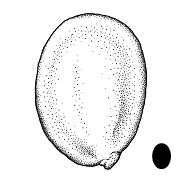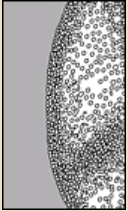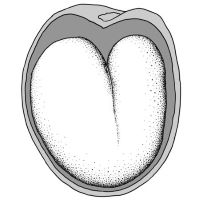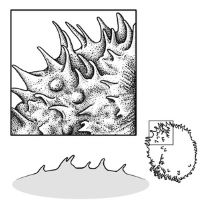Content is from Kirkbride et al. 2006Kirkbride et al. 2006:
Kirkbride JH, Jr, Gunn CR, and Dallwitz MJ. 2006. Family guide for fruits and seeds, vers. 1.0. Accessed September 2020-January 2022. URL: https://nt.ars-grin.gov/seedsfruits/keys/frsdfam/index.cfm ., without modification.
Updates are forthcoming.
Fruits: Pistil(s) compound; 1; 1-pistillate; with carpels united. Fruit pericarpium; simple, or schizocarpschizocarp:
usually dry fruit splitting between two or more locules to form distinct, indehiscent, usually one seeded segments; fruit derived from a single, superior or inferior, compound ovary; compare to mericarp ; capsulecapsule:
; capsulecapsule:
a dry, dehiscent fruit derived from a compound ovary (Stegnosperma - not Spjut), or samarasamara:
(Stegnosperma - not Spjut), or samarasamara:
a winged, indehiscent, dry fruit containing a single (rarely two) seed(s) ; baccarium (Spjut 6 families: Apocynaceae, Oleaceae, Phytolaccaceae, Sapindaceae, Saururaceae, Tropaeolaceae); capsulecapsule:
; baccarium (Spjut 6 families: Apocynaceae, Oleaceae, Phytolaccaceae, Sapindaceae, Saururaceae, Tropaeolaceae); capsulecapsule:
a dry, dehiscent fruit derived from a compound ovary not inflated; capsulecapsule:
not inflated; capsulecapsule:
a dry, dehiscent fruit derived from a compound ovary without operculumoperculum:
without operculumoperculum:
a dehiscent cap (or lid) of a seed or fruit that opens during germination or dehiscence ; without persistent central column; not within accessory organ(s), or within accessory organ(s); within calyxcalyx:
; without persistent central column; not within accessory organ(s), or within accessory organ(s); within calyxcalyx:
the outer whorl of the perianth; all the sepals of a flower ; 1-seeded to many-seeded; 1-seeded (to many); with 2-carpellate (to many); with carpels united, or separate; with carpels remaining united at maturity; without sterilesterile:
; 1-seeded to many-seeded; 1-seeded (to many); with 2-carpellate (to many); with carpels united, or separate; with carpels remaining united at maturity; without sterilesterile:
lacking male and/or female reproductive parts; also, not producing fruit or seed
 carpels; not sulcatesulcate:
carpels; not sulcatesulcate:
surface relief—having one or more elongate, relatively narrow and shallow depressions or grooves ; in transection tereteterete:
; in transection tereteterete:
approximately circular in cross section; width and thickness approximately equal
 ; apexapex:
; apexapex:
the point farthest from the point of attachment, or the "tip" of an organ not beaked; wall leatheryleathery:
not beaked; wall leatheryleathery:
texture—moderately thick, tough, and very pliable
, or fleshy, or woodywoody:
texture—consisting mainly of indurate lignified tissues, characteristic of or resembling wood
; dehiscentdehiscent:
(v. dehisce) splitting open at maturity to release contents (of a fruit) , or indehiscentindehiscent:
, or indehiscentindehiscent:
not opening on its own, as in a fruit
 . Dehiscentdehiscent:
. Dehiscentdehiscent:
(v. dehisce) splitting open at maturity to release contents (of a fruit) unit seed(s). Dehiscentdehiscent:
unit seed(s). Dehiscentdehiscent:
(v. dehisce) splitting open at maturity to release contents (of a fruit) passively (assumed); and shedding seeds; without replumreplum:
passively (assumed); and shedding seeds; without replumreplum:
the rim, formed by the persistent placentas, and connected by a false septum in Brassicaceae fruits. The fruit valves are attached to this rim and separate from it in dehiscent fruits.
. Epicarpepicarp:
outer layer of fruit wall or pericarp, if divided into layers; note here used synonymously with exocarp black; shinyshiny:
black; shinyshiny:
uniformly reflecting a high proportion of incident light at all angles , or dulldull:
, or dulldull:
reflecting only a low proportion of incident light, with no apparent sheen ; durable; glabrousglabrous:
; durable; glabrousglabrous:
without hairs
; without armature, or with armature; with spines; without armature glochidiate; smooth, or not smooth; with wing(s), or without wing(s); 1-winged; with wing(s) encompassing (Semonvillea), or apicalapical:
at or pertaining to the end of the seed or fruit distal from its point of attachment (i.e., base)
(Seguieria); without apicalapical:
at or pertaining to the end of the seed or fruit distal from its point of attachment (i.e., base)
respiratory hole. Mesocarpmesocarp:
the middle layer of the pericarp, if divided into layers present; fleshy; composed of 1 unified layer; without lactiform cavity system. Endocarpendocarp:
present; fleshy; composed of 1 unified layer; without lactiform cavity system. Endocarpendocarp:
the inner layer of the pericarp, if divided into layers present, or absent; not separating from exocarpexocarp:
present, or absent; not separating from exocarpexocarp:
outer layer of fruit wall or pericarp, if divided into layers; note here used synonymously with epicarp ; thin; not splitting into 1-seeded pyrenes; smooth; without wing; without operculumoperculum:
; thin; not splitting into 1-seeded pyrenes; smooth; without wing; without operculumoperculum:
a dehiscent cap (or lid) of a seed or fruit that opens during germination or dehiscence ; without secretory cavities; without mechanism for seedling escape; without grooves; without longitudinallongitudinal:
; without secretory cavities; without mechanism for seedling escape; without grooves; without longitudinallongitudinal:
of or relating to length or the lengthwise dimension
ridges. Funiculusfuniculus:
(alt. funicle) stalk connecting the ovule (later seed) to the ovary (later fruit) placenta short; short without seed bearing hookswith hooks:
short; short without seed bearing hookswith hooks:
bristles or spines with curved or backwards pointing tips, or with secondary bristles along their length (retinacula); not persisting in fruit after seed shed.
(retinacula); not persisting in fruit after seed shed.
Seeds: Arilaril:
(broad sense) appendicular structure that wholly or partly envelops a seed and is produced from or a modification of the funicle, raphe, or outer integument; usually fleshy or pulpy, sometimes spongy or tufted-capillate, often brightly colored absent, or present (Barberia, Stegnosperma); a true arilaril:
absent, or present (Barberia, Stegnosperma); a true arilaril:
(broad sense) appendicular structure that wholly or partly envelops a seed and is produced from or a modification of the funicle, raphe, or outer integument; usually fleshy or pulpy, sometimes spongy or tufted-capillate, often brightly colored ; Stegnosperma red, or yellow (Barbeuia); well developed; adnate to hilumhilum:
; Stegnosperma red, or yellow (Barbeuia); well developed; adnate to hilumhilum:
on seeds, the scar indicating where the funiculus was attached; on grass caryopses, the scar visible on the outer fruit surface revealing where the seed is attached on the inner fruit wall surface; or in Asteraceae cypselae, the scar visible on the outer fruit wall revealing where the fruit was attached to the receptacle ; fleshy; of funicularfuniculus:
; fleshy; of funicularfuniculus:
(alt. funicle) stalk connecting the ovule (later seed) to the ovary (later fruit) placenta origin; marginalmarginal:
origin; marginalmarginal:
at, on, or close to the margin or border
; saccate. Seed larger than minute; less than 1 mm long and 1 to less than 5 mm long; 1–4 mm long; circularcircular:
(of embryo) linear embryo is curved into an "O" shape , or linearlinear:
, or linearlinear:
(shape) long, narrow, and uniform in width; (of embryo) embryo is straight and much longer than wide , or oblongoblong:
, or oblongoblong:
2D shape—much longer than broad with nearly parallel sides, corners are rounded , or reniformreniform:
, or reniformreniform:
2D or 3D shape—kidney-shaped , or ellipsoidellipsoid:
, or ellipsoidellipsoid:
3D shape—elliptic
, or ovaloval:
2D shape—elongate, widest at the middle, and symmetrically convex-attenuate to rounded ends ; in transection compressedcompressed:
; in transection compressedcompressed:
flattened; in grasses, used to denote compression (not necessarily flattened) either laterally or dorsiventrally
; not bowl shaped; not nutlike; without winglike beakbeak:
a usually firm, terminal appendage, sometimes tapered ; without caudatecaudate:
; without caudatecaudate:
tapering to a long, tail-like appendage appendage(s); at maturity with food reserves; with perispermperisperm:
appendage(s); at maturity with food reserves; with perispermperisperm:
seed nutritive tissue comparable to the endosperm, but derived from the nucellus (maternal tissue)
, or endosperm; without canavanine. Sarcotestasarcotesta:
pulpy or fleshy outer layer of the seed coat, simulates aril absent. Testatesta:
absent. Testatesta:
seed coat
 present; without markedly different marginalmarginal:
present; without markedly different marginalmarginal:
at, on, or close to the margin or border
tissue; without fleshy or leatheryleathery:
texture—moderately thick, tough, and very pliable
layer over hard layer; tight; shinyshiny:
uniformly reflecting a high proportion of incident light at all angles ; surface smooth, or unsmooth; surface with merged raised features; surface striatestriate:
; surface smooth, or unsmooth; surface with merged raised features; surface striatestriate:
surface relief—having fine, parallel lines, grooves or ridges ; with crease or line separating cotyledons from hypocotyl-radicle, or without crease or line separating cotyledons from hypocotyl-radicle; with notch along margin where cotyledons from hypocotyl-radicle tip approaching each other, or without notch along margin where cotyledons from hypocotyl-radicle tip approach each other; without glands; without bristles; glabrousglabrous:
; with crease or line separating cotyledons from hypocotyl-radicle, or without crease or line separating cotyledons from hypocotyl-radicle; with notch along margin where cotyledons from hypocotyl-radicle tip approaching each other, or without notch along margin where cotyledons from hypocotyl-radicle tip approach each other; without glands; without bristles; glabrousglabrous:
without hairs
, or pubescentpubescent:
surface relief—bearing hairs
(Rivinia whose hairs are from endocarpendocarp:
the inner layer of the pericarp, if divided into layers ); without glandularglandular:
); without glandularglandular:
surface relief—covered with small, raised secretory glands, regular or irregularly shaped, translucent or opaque, and maybe distinctly colored pubescence; without wings; without collar; without operculumoperculum:
pubescence; without wings; without collar; without operculumoperculum:
a dehiscent cap (or lid) of a seed or fruit that opens during germination or dehiscence ; colored; monochrome; black; membranousmembranous:
; colored; monochrome; black; membranousmembranous:
texture—extremely thin, pliable, and fairly tough
, or crustaceouscrustaceous:
texture—thin, dry, indurate, and brittle
; not becoming mucilaginousmucilaginous:
resembling mucilage; moist and sticky
when wetted; surrounding embryo. Hilumhilum:
on seeds, the scar indicating where the funiculus was attached; on grass caryopses, the scar visible on the outer fruit surface revealing where the seed is attached on the inner fruit wall surface; or in Asteraceae cypselae, the scar visible on the outer fruit wall revealing where the fruit was attached to the receptacle punctate. Rapheraphe:
punctate. Rapheraphe:
a ridge or seam on the seed coat, formed by the portion of the funiculus united to the ovule wall in longitudinally curved ovules conspicuous; texture as testatesta:
conspicuous; texture as testatesta:
seed coat
 ; as long as seed; included in dehisced fruit. Endosperm development nuclear. Perispermperisperm:
; as long as seed; included in dehisced fruit. Endosperm development nuclear. Perispermperisperm:
seed nutritive tissue comparable to the endosperm, but derived from the nucellus (maternal tissue)
copious; crystalline granulargranular:
surface relief—having a grainy surface , or mealymealy:
, or mealymealy:
loose, dry, and disintegrating in finely granular
pieces like meal or flour
, or soft; with starch; with starch composed of clustered grains; semi transparent, or opaqueopaque:
not transmitting light
; smooth. Embryo differentiated from food reserve; well developed; 1 per seed; partially filling testatesta:
seed coat
 (with food reserve), or nearly filling testatesta:
(with food reserve), or nearly filling testatesta:
seed coat
 (trace or scanty food reserve); 1–2.3 times the length of food reserve; at one end of seed not extending into a depression or cup; peripheralperipheral:
(trace or scanty food reserve); 1–2.3 times the length of food reserve; at one end of seed not extending into a depression or cup; peripheralperipheral:
(of embryo) embryo is curved around the outer edge of the seed, near the seed coat
; linearlinear:
(shape) long, narrow, and uniform in width; (of embryo) embryo is straight and much longer than wide , or foliatefoliate:
, or foliatefoliate:
appearing leaf-like
; bentbent:
(of embryo) embryo is bent at an acute, V-shaped angle with the ends close together and generally thick cotyledons , or arcuate, or C-shapedC-shaped:
, or arcuate, or C-shapedC-shaped:
2D-shape—semiannulate, curved into the shape of the letter 'C'
, or straight, or annularannular:
3D shape—forming a ring ; 90% annularannular:
; 90% annularannular:
3D shape—forming a ring , or 100% annularannular:
, or 100% annularannular:
3D shape—forming a ring , or 125% annularannular:
, or 125% annularannular:
3D shape—forming a ring ; usually surrounding perispermperisperm:
; usually surrounding perispermperisperm:
seed nutritive tissue comparable to the endosperm, but derived from the nucellus (maternal tissue)
; with cotyledons gradually connected to hypocotyl-radicle; without coleorhiza; without simmondsin; without stomata; not green; with 2 or more cotyledons. Cotyledons 2; well developed; 0.5–0.7 times length of embryo; as wide as hypocotyl-radicle; 1–1.5 times wider than hypocotyl-radicle; not concealing hypocotyl-radicle; foliaceous, or not foliaceous; thin; flat, or convoluted; smooth; with apicesapex:
the point farthest from the point of attachment, or the "tip" of an organ entire; with margins separate; basally entire; equal in size, or unequal in size (Barbeuia); not punctatepunctate:
entire; with margins separate; basally entire; equal in size, or unequal in size (Barbeuia); not punctatepunctate:
surface relief—dotted with pits or with translucent, sunken glands or with colored dots, similar to pitted dotted. Hypocotyl-radicle moderately developed to well developed; curvedcurved:
dotted. Hypocotyl-radicle moderately developed to well developed; curvedcurved:
(of embryo) linear embryo is curved into an arch or horseshoe with the ends far apart ; not thickened.
; not thickened.
 of Agdestis. Goldberg: recognized Agdesidaceae (fruit unilocular, 1-seeded nutletnutlet:
of Agdestis. Goldberg: recognized Agdesidaceae (fruit unilocular, 1-seeded nutletnutlet: lobes), Barbeuiaceae (fruit woodywoody:
lobes), Barbeuiaceae (fruit woodywoody: ), Petiveriaceae & Phytolaccaceae (fruits berryberry:
), Petiveriaceae & Phytolaccaceae (fruits berryberry: , samarasamara:
, samarasamara: , or spinyspiny:
, or spinyspiny: nutletnutlet:
nutletnutlet: , valves separating to base).
, valves separating to base).
Literature specific to this family: Liogier, H.A. 1985. Descriptive flora of Puerto Rico and adjacent islands, vol 1. Universidad de Puerto Rico, San Juan.
General references: Baillon, H.E. 1866–95. Histoire des plantes, 13 vols. Hachette & Co., Paris, Corner, E.J.H. 1976. The seeds of Dicots, esp. vol. 2. Cambridge University Press, New York, Cronquist, A. 1981. An integrated system of classification of flowering plants, 1,262 p. Columbia University Press, New York, Gaertner, J. 1788–1805. De fructibus et seminibus plantarum. The Author, Stuttgart, Goldberg, A. 1986 (dicots) & 1989 (monocots). Classification, evolution, and phylogeny of the familes of Dicotyledons. Smithsonian Contr. Bot. 58 for dicots (314 pp.) & 71 for monocots (74 pp.). [Goldberg's illustrations are reproduced from older publications and these should be consulted], Gunn, C.R. & C.A. Ritchie. 1988. Identification of disseminulesdisseminule:
detachable plant part capable of being disseminated and of propagating, commonly a seed or fruit
listed in the Federal Noxious Weed Act. Techn. Bull. U.S.D.A. 1719:1–313, Gunn, C.R., J.H. Wiersema, C.A. Ritchie, & J.H. Kirkbride, Jr. 1992 & amendments. Families and genera of Spermatophytes recognized by the Agricultural Research Service. Techn. Bull. U.S.D.A. 1796:1–500, LeMaout, E. & J. Decaisne. 1876. A general system of botany, 1,065 p. Longmans, Green, & Co., London, Mabberley, D.J. 1987. The plant-book, 706 p. Cambridge University Press, Cambridge, Martin, A.C. 1946. The comparative internal morphology of seeds. Amer. Midl. Naturalist 36:513–660, Spjut, R.W. 1994. A systematic treatment of fruit types. Mem. New York Bot. Gard. 70:1–182, and Mirle, C. & R.J. Burnham. 1999. Identification of asymmetrically winged samarassamara:
a winged, indehiscent, dry fruit containing a single (rarely two) seed(s) from the Western Hemisphere. Brittonia 51:1–14.
from the Western Hemisphere. Brittonia 51:1–14.